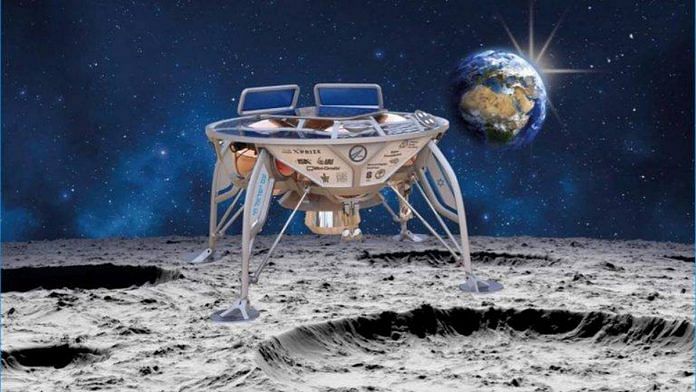Bengaluru: Watch out, moon! The private players are coming. Come Friday, a spacecraft will take off for the moon, hoping to establish a series of firsts: If successful, it will be the first fully privately-funded spacecraft on the moon, the first Israeli mission to Earth’s satellite, as well as the cheapest and lightest rover to land there.
Once there, it will tip its hat to the zeitgeist of the current times, and send back a selfie before it gets to work on its actual mission.
SpaceIL, a private space company operating out of Israel, and the government-owned Israel Aerospace Industries held a press conference this week where they announced the launch of ‘Genesis’ (‘Beresheet’ in Hebrew), scheduled for 7.15 am IST Friday, after missing the December 2018 deadline.
SpaceIL was a contestant in the Google Lunar XPRIZE, a competition that offered $20 million to any private player that could land and operate an unmanned spacecraft on the moon. India’s TeamIndus was among the five shortlisted contenders along with SpaceIL, but the contest expired after none could meet the 31 March 2018 launch deadline.
Eyes on moon’s magnetism
Genesis will be launched aboard a SpaceX Falcon rocket from Cape Canaveral in Florida, US.
The craft will perform six orbit-raising manoeuvres — a technique ISRO’s satellites are famous for — to reach the moon and land on the lunar surface. The landing is currently scheduled for 11 April, after the spacecraft spends over seven weeks in orbit around the Earth and undertakes a subsequent journey in space.
The craft is 2m x 1.5m in dimension (roughly the size of a Tata Nano), and will weigh 585 kg at launch, 400 kg of that being the weight of fuel. The rover will contain two science payloads: A magnetometer (an instrument to measure magnetism) built by the Weizmann Institute of Science, Israel, and a laser retroreflector array, built by NASA.
When it lands on the moon, the spacecraft will weigh 180 kg, having shed all the fuel. Its scientific objective is to measure the magnetic field of the moon.
Also read: India and China are greener than you think, says NASA
A window into the past
Genesis will take off for the moon as a time capsule that will allow future space explorers a peek at contemporary Israel. It will contain digital data about the company, its employees, the project, and also national symbols and cultural items, including a microscopic Bible.
The landing site is a little north of Mare Serenitatis or Sea of Serenity, visible to us from Earth.
Landing on the near side of the moon ensures that there is direct contact with Earth — and by extension, mission control — at all times.

Once it lands, the craft will immediately start photographing its environment and also send back a selfie.
Presence on the moon
SpaceIL was founded in 2011 in response to the Google Lunar XPrize, by three young engineers — Yariv Bash, Kfir Damari, and Yonatan Winetraub.
The company raised nearly $100 million, mostly through donations made by individuals such as businessmen Sheldon Adelson (US) and Morris Kahn (Israel).
SpaceIL has been supported by not just the Israel Space Agency and other Israeli aerospace companies, but also educational institutions and universities.
In 2015, it became the first Google Lunar XPrize team to sign a launch contract.
The organisation has been very active with outreach and education, going into schools and classrooms. Its website states that one of company’s primary objectives is education and encouraging more children and students to take up STEM.
If successful, Israel will join the ranks of the US, the erstwhile Soviet Union, China, and possibly India, when Chandrayaan 2 launches soon, as a country that has landed a craft on the surface of the moon.
Also read: NASA’s Mars rover Opportunity finally falls silent



